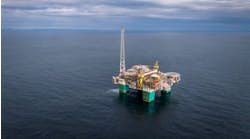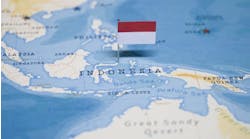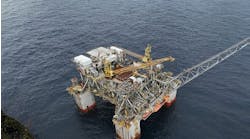European contractors are struggling to batten down costs consumed by North Sea production floaters, but construction schedule overruns are not as bad as rumors suggest. This subject was a major issue at the 14th Annual Floating Production Systems Conference in London, organized by IBC Global Conferences. The negative aspects were touched on by Inge Laskemoen, Senior Vice President for Field Development at Kværner Oil & Gas Norway. He outlined events leading to delivery of the Jotun FPSO to Esso.
Jotun is a joint development of three fields in the Norwegian North Sea, called Elli, Elli South, and Tau. For a Norwegian project, the international content is unusually high - operator Esso and Enterprise each own 45%, with the balance held by Statoil, Conoco, and Amerada Hess. Production, which started last October, is derived through wells drilled from a wellhead platform, with oil and gas exported to the floating production,storage, and offloading (FPSO) vessel, which in turn offloads to shuttle tankers. The location is 165 km west of Haugesund, in 126 meters of water.
Kværner gained the EPIC contract for the FPSO in April 1997. First oil was achieved 30 months later.
New challenges arose each day of those 30 months, according to Laskemoen - but the stiffest emerged before the contract had even been awarded. In 1996, Kværner had been toying with a new hull design developed by its Masa Yard division in Finland, which was about to be deployed in a floating storage unit on Norsk Hydro's Field.
Schedule driven
Modifications were required, however, particularly to the turret, in order to convert this concept into a seaworthy FPSO. In November that year, Kværner took the gamble of ordering a vessel based on this design from Masa Yards - in anticipation of winning the Jotun prize. That risk had to be taken, Laskemoen claimed, because of Esso's tight schedule for this project. "It was necessary to start several engineering activities on the topside facilities at this stage prior to award of the FPSO contract, in order to provide interface information from the topside facilities design needed for the detailed design of the vessel."
Esso had demanded a 20-year working life for the vessel, with no drydocking in that period. Long discussions ensued between Kværner and Esso over how to interpret this 20-year rule, which differed from the detailed specs in the shipbuilder's tender. Compromises were eventually reached, but these enforced some re-design and changes to the fabrication process.
Added complications followed. Late in the conceptual engineering phase, the field partners decided that the FPSO should itself provide saleable gas for direct export into the Statpipe trunkline system (unlike other FPSOs, which deliver their gas untreated for clean-up elsewhere). Accommodating this late change proved to be a struggle. "As a result, we got out of sequence in ordering the topside processing equipment," Laskemoen said.
Waves dictate change
A further dilemma was the potential impact of severe weather on the hull. Model tests had shown that large waves in this location would deposit green water onto the deck. Further analysis suggested that the quantity and impact could be significant, leading to further very late design changes being imposed. "The cost consequences became more significant than they could have been," said Laskemoen. Major improvements that had to be instituted included protection of cable racks, the deluge skid with bulkheads, more protection wall for the emergency generator and re-routing of the exhaust duct, and structural reinforcement of the escape route and other structures.
At the time of construction, many other North Sea gas development projects were also underway, many incurring serious schedule/ cost overruns. Kværner and Esso tried to keep a lid on potential problems by strengthening the Jotun project team. They created an "alignment initiative" to aid staff interaction at all levels and thereby improve execution of the project.
However, planning and execution problems continued to surface. As the project progressed, it emerged that the FPSO tender had been based on a concept that was not sufficiently matured. Topsides modification had to be performed at the detailed design phase. In turn, process overlapped into the detailed engineering phase, forcing further widespread modification. These overruns put engineering as a whole out of sequence. The effect of performing so many activities in parallel was to increase the strain on human resources to meet schedules.
That situation was exacerbated by the high workload at the time in Norwegian yards, which meant that local pre-fabrication support staff was not readily available. "We had to buy to higher cost and lower quality," said Laskemoen, "resulting in reduced productivity."
With delays hitting all main deliveries to the Jotun assembly site in Stavanger, Kvarner decided to insist on earlier arrival of outstanding packages such as the compression unit, "in order to have the major units lifted onboard the vessel for completion under our own control. There was more carry-over work than expected, and too many problems surfaced during completion and commissioning activities. This again resulted in increased workload to the assembly site, and further challenges regarding completion of the vessel."
Other challenges
Other problems that had to be faced included:
- FPSO's mooring anchor chains: These had been installed prior to arrival of the vessel, and were lying on the seabed waiting to be lifted up. After the majority had been pulled in, some twisting of the chain was encountered due to sideways pulling. The chain locked in the guiding system, and as a result, the pulling method had to be modified
- Flushing and preservation: The heating and cooling medium systems were flushed and preserved prior to sailaway from the yard, but preservation proved unsatisfactory. Chemical flushing was needed to clean the system properly. Esso, which had global expertise in this field, worked with Kværner to find a chemical medium applicable to the completed system which could be used without destroying gaskets and seals.
- Firewater systems: Some vibration was being experienced, which led to significant repair and re-design of some of the firefighting water system components.
"For many of the FPSOs built in recent years," Laskemoen concluded in his pre sentation, "the production facilities are more complex and the execution time and invest ments are at another level compared to the more simple design. The main reasons for these differences are:
- Long field life
- Environmental requirements - zero emissions philosophy
- Production of crude of a quality to achieve the best possible market price
- For Jotun, gas production to sales quality
Jotun's FPSO, which has a design capacity of 89,000 b/d, plus water treatment at 122,000 b/d, water injection at 190,000 b/d, and gas compression at 53 MMcf/d, was delivered five months later than originally planned. Compared to other recent North Sea FPSOs, this is reasonably good, Laskemoen claimed. In general, floaters are still being produced quicker than fixed platforms of similar capability, he claimed, and at lower cost.


